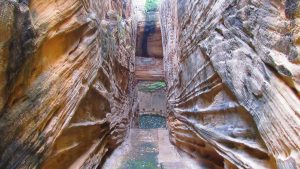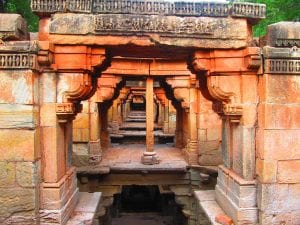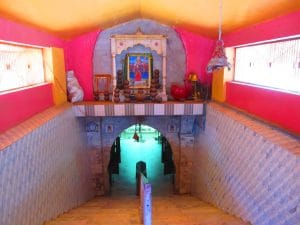With the mercury inching closer to the 40 degree mark, it promises to be a truly hot summer, perhaps made a shade warmer by the General Elections and its accompanying rhetoric. There is no better time to talk about structures associated with water than the onset of the dry season. Especially when the structures in question are not merely holes in the ground but richly decorated historical step-wells that were not just a perennial source of water for the people around but also a power statement for those who built them.

The Vav as a power statement, Rudabai Vav at Adalaj, in Gandhinagar district
This story comes a decade after one of India’s finest step-wells, Rani-Ki-Vav at Patan, Gujarat, was recognised with UNESCO World Heritage Status. While that status was overdue, what most visitors to the step-well tend to entirely miss is that this structure is not in isolation, but represents the acme of a building tradition in Gujarat that goes back centuries. We explore a few examples:
Dholavira, Building Water Reservoirs: The first steps towards this tradition were probably taken in the Sindhu Saraswati site of Dholavira, in Kutch. Here, excavations have revealed evidence of an extensive water management system. Given the area’s history of prolonged droughts, the inhabitants built a network of stone bunds and sloping channels through which water was brought from the catchment areas of the rivers into storage reservoirs. Remains of these reservoirs are found all over the city, including two of massive size. A 2014 excavation also revealed a step-well whose dimensions make it thrice as big as the Great Bath of Mohenjodaro. All this is ample evidence of sophisticated hydraulic engineering.
Junagarh, Origin of the ‘Vav’: Over 360 kms south and crossing a span of many centuries, the evidence of such engineering becomes even more magnified – in the form of two structures inside Junagarh’s Uparkot Fort. These Vavs, as step-wells are called in Gujarat, represent an early form of step-well development.
The basic form of a step-well was when an underground aquifer was identified and a vertical shaft dug till water was found, thus forming a well. A horizontal path, via a gentle gradient, was then created towards the well shaft to make access easier for water carriers – usually women. In summer, women would have to often walk the entire length of the path to draw water from the well itself. Over time, the paths made way for steps and Vavs became increasingly elaborate.
Inside Uparkot though, the Vavs are basic in nature. The Adi Kadi Vav, nearly a thousand years old, has no embellishment at all. A narrow, sloping path cuts through rock while leading downward, sans any steps. The air feels different in its subterranean depths, making it a surreal experience.

Inside the Adi Kadi Vav in Junagarh’s Uparkot fort – the most basic form of a stepwell
Elsewhere in Uparkot is the more elaborate Navghan Kuo. Part natural and part man-made, it is accessed via a narrow entrance, which unexpectedly opens into a large and airy forecourt. After the oppressive heat of the surface level, it feels cool within. A side wall has several niches, home to flocks of pigeons. One can imagine the former royals retreating to this cool place on days when the heat outside became unbearable. Beyond the forecourt is a massive well-shaft – in term of both depth and width. In its heyday, the well is said to have had enough water to ensure the fort withstood a siege.
Rampura, Step-wells Turn Shrines: The step-wells were not just sources of water but rapidly became community congregation centers and given the value of water to people in semi arid or drought prone regions, many had divine iconography built into them. Today, some Vavs – such as the 15th century CE Ratala Vav in Rampura village, Surendranagar – are visited for prayer, not water.

Carved icons on the pavilion towers inside the Vav at Rampura, in Surendranagar district
The Ratala is huge but being largely underground, with very little of its structure being visible from a distance. Two of its six pavilion towers seem to have been entirely turned into shrines, their alcoves containing sculptures depicting a Shesasayi Vishnu and the Navgarahas. Further underground, the cleanliness of the upper level shrines gives way to neglect and filth with the iconography barely visible.
Adalaj, the Step-well as a Status Symbol: With the Vavs being public congregation points, building them was considered a work of great importance. Little surprise then that most of the step-wells that survive in Gujarat today are attributed to either those with political power or wealthy merchants. The Rudabai Vav at Adalaj, just north of Ahmedabad, is an example of the former.
As in the case of the Vav at Patan, this one too is believed to have a woman as its patron-builder. Ruda, after whom the step-well is named, was the consort of the Vaghela chief Virasimha. An inscription in the well dates it to 1499 CE. The well has a stepped corridor which descends underground with four pavilions across five levels. Almost as richly embellished as Patan, the recurring motif here is that of fighting elephants.
Ahmedabad, Vavs Survive as Temples: Gujarat’s largest city too has several step-wells dotting its congested landscape. And not surprisingly, most of those that survive have done so because they have transformed into temples, such as the Ashapura Ni Vav (Bapunagar), Gandharva Ni Vav (Saraspur) and the Khodiyar Mata Ni Vav (Vastral). In the last case, the Khodiyar Mata is depicted with a crocodile as her vehicle. One day, a real crocodile found its way to the temple sparking off huge excitement among the faithful.

The inside of the Khodiyar Mata ni Vav in Ahmedabad, which is now a temple
A few other Vavs are protected monuments, at least by way of a board and restricted access, namely the Dada Harir Vav (Asarwa) and one named after a merchant called Jethabai.
The British Spell Doom for the Vavs: With the step-wells being so significant in communities, it seems strange that almost all of them today are closed for their original purpose. The blame for that has to be put on the British. Horrified by the fact that the unsanitary seeming step-wells were the common source of both drinking and bathing water, the British began establishing pipes, pumps and taps. Their objective was to keep out the guinea worm, a waterborne parasite, from drinking water. They succeeded all too well, and in doing so, ensured that step-wells became obsolete even for the bathing purposes.
In conclusion, one can point to the saddest part of the story being the point that modern-day India continues to use the British system without any change. However, with groundwater levels dropping alarmingly all over the country, maybe it is time to revisit the use of step-wells to improve groundwater.
Remember, step-well construction was done with ground water enhancement in mind: the rainwater running off into the bottom of the well percolated down into the ground till it reached an impermeable layer of soil. While the soil absorbed the silt, what was left above was clear water. The Vavs of yesterday may not be sources of drinking water nor do all of them have religious significance, but in their subterranean recesses may lie a solution to many water shortage problems.
The author is a heritage explorer by inclination with a penchant for seeking obscure sites. A brand consultant by profession, he tweets @HiddenHeritage. Views expressed in the above piece are personal and solely those of the author. They do not necessarily reflect Firstpost’s views.
News Related-
Anurag Kashyap unveils teaser of ‘Kastoori’
-
Shehar Lakhot: Meet The Intriguing Characters Of The Upcoming Noir Crime Drama
-
Watch: 'My name is VVS Laxman...': When Ishan Kishan gave wrong answers to right questions
-
Tennis-Sabalenka, Rybakina to open new season in Brisbane
-
Sikandar Raza Makes History For Zimbabwe With Hattrick A Day After Punjab Kings Retain Him- WATCH
-
Delayed Barapullah work yet to begin despite land transfer
-
Army called in to help in tunnel rescue operation
-
FIR against Redbird aviation school for non-cooperation, obstructing DGCA officials in probe
-
IPL 2024 Auction: Why Gujarat Titans allowed Hardik Pandya to join Mumbai Indians? GT explain
-
From puff sleeves to sustainable designs: Top 5 bridal fashion trends redefining elegance and style for brides-to-be
-
The Judge behind China's financial reckoning
-
Arshdeep Singh & Axar Patel Out, Avesh Khan & Washington Sundar IN? India's Likely Playing XI For 3rd T20I
-
Horoscope Today, November 28, 2023: Check here Astrological prediction for all zodiac signs
-
'Gurdwaras are...': US Sikh body on Indian envoy's heckling by Khalistani backers
